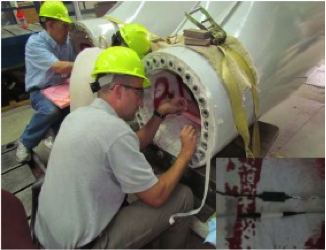Wind-plant underperformance is estimated to reduce revenue by 10% to 40% percent due to turbine–turbine interaction and represents the most significant opportunity to reduce the levelized cost of wind energy. The U.S. Department of Energy has established the Wind Plant Optimization Center, also called the Atmosphere to Electrons [A2e] program, to facilitate a national focus on improving wind plant underperformance. This project’s purpose is to support the DOE Wind Plant Optimization Center/A2e.

Several major Research and Development challenges exist for this project:
- A fundamental turbine–turbine interaction data set is necessary to fully understand the problem and guide future development efforts (turbine placement, turbine design, rotor design, wind plant control, and/or standards improvement).
- A publically accessible database of turbine–turbine interaction information is needed to multiply the impact of this research by leveraging the broader research community and developing simulation capabilities in industry, academia, and at the national laboratories.
- Detailed measurement/experimental imaging at high resolution and high sample rates will be critical to the future research and development of wind plant technology. These measurements will be made in the areas 1 to 3 rotor diameters downwind from the turbines.

This project will lead to a reduction in wind plant under-performance, an increase in revenue, a decrease in damage-causing loads, and a savings in operations and maintenance costs through the collection of the unique measurements and the derivation of new technologies and methods from those measurements.
The project is designed to support Original Equipment Manufacturer (OEM) and owner/operator efforts to improve performance and reduce O&M costs. The project described is open research, but the facility will have the capability to expand into advanced proprietary research. The dissemination of the results will be relevant to, and service, the industrial, academic and laboratory research community.
The tasks of this project will address research and development challenges:
- Baseline turbine–turbine interaction study through a standard International Electrotechnical Commission (IEC) performance test and data quality assurance of the DOE SWiFT Facility.
- Development of a database and data portal to enable easy and rapid transmission of unique high fidelity data to the research community.
- Field testing at the SWiFT Facility of the novel Sandia Wake Imaging Measurement System which is to produce high resolution, high sample rate images of the detailed wake structure around a wind turbine (as opposed to state-of-the-art averaged data in a few points).
- DOE and Wind Plant Optimization Center programmatic and technical support.
The SWiFT facility held its commissioning ceremony and hardware installation during fiscal year 2013. As Sandia moves into the research phase of the facility’s existence, we will support research projects such as:
- Turbine–turbine interaction studies using the National Rotor Testbed project using blades which are heavily instrumented for structural and aerodynamics analysis.
- An operational deployment of near-real-time data portal and automatic data quality assurance.
- A detailed field testing campaign at SWiFT using the Wake Imaging Measurement System.
- Design of rotors tailored for improved wind-plant performance.
- Baseline acoustic-beam-forming array measurements.